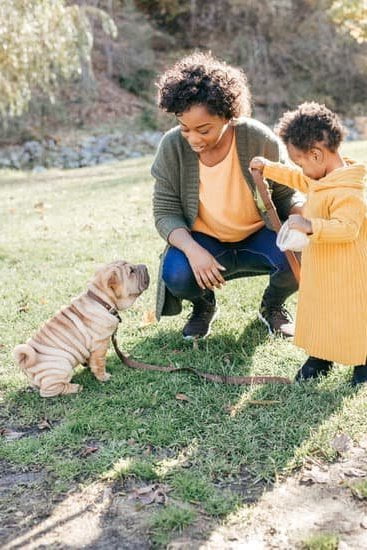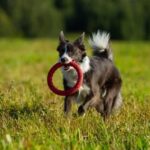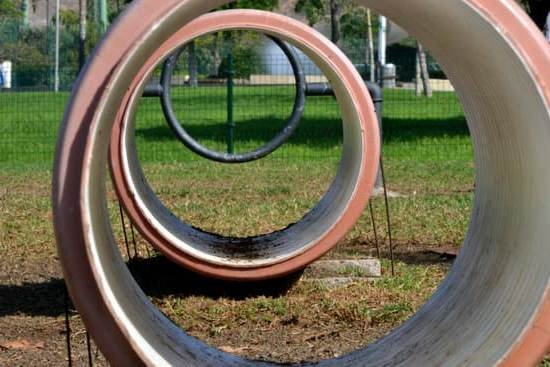House training is a fundamental aspect of owning a dog, and it is crucial for both the well-being of your pet and the harmony of your home. When done successfully, house training not only prevents accidents and messes but also creates a strong bond between you and your furry friend. In this comprehensive guide, we will delve into the various aspects of fully house training a dog.
In the first section, we will explore the significance of house training for dogs. From maintaining cleanliness to fostering good behavior, house training plays a vital role in ensuring the happiness and comfort of both you and your canine companion. We will also discuss how proper house training can prevent destructive behaviors such as chewing or marking territories.
Next, we will dive into the basics of house training. Identifying key factors like consistency, patience, positive reinforcement, and establishing routines will form the foundation for successful house training. These elements are essential in teaching your dog where to eliminate and instilling good habits that will last a lifetime.
Preparing your home for successful house training requires careful consideration as well. From blocking off certain areas to providing appropriate toileting options, this section will cover all the necessary preparations to set your dog up for success.
Stay tuned as we guide you through each step of the house training process. With insights into crate training as a valuable tool, troubleshooting common challenges, dealing with accidents, and maintaining long-term success, this article aims to be your go-to resource for fully house training your furry friend. Let’s embark on this journey together towards a happy and well-trained dog.
The Basics
House training a dog is a necessary and important step in ensuring that your canine companion becomes a well-behaved and respectful member of your household. While it may seem like a daunting task, understanding the key factors involved in house training can make the process much easier and more successful.
One of the first key factors to consider when house training your dog is understanding their natural instincts and behaviors. Dogs are naturally clean animals and do not prefer to eliminate where they sleep or eat. This is an important factor to keep in mind when setting up their designated elimination area in your home. By providing them with a clear and separate space for elimination, you can help reinforce this instinct and make the house training process smoother.
Another important factor in house training is consistency. Dogs thrive on routine and structure, so establishing a consistent schedule for feeding, outings, and potty breaks is crucial. Consistency helps dogs understand what is expected of them and reinforces good behavior. Be sure to take your dog out regularly throughout the day, especially after meals or waking up from naps, as these are prime times for elimination.
Additionally, positive reinforcement plays a vital role in house training. Rewarding your dog with praise, treats, or playtime when they eliminate in the appropriate area reinforces their good behavior and motivates them to repeat it. It’s essential to use positive reinforcement immediately after your dog eliminates to create an association between the action and the reward.
By understanding these key factors involved in house training, you can lay a solid foundation for success in teaching your dog proper elimination habits. Remember that patience and consistency are key throughout this process, as accidents will likely happen along the way. With time, effort, and dedication, you can successfully house train your dog and ensure long-term success.
Preparations
One of the key factors in successfully house training a dog is setting up your home for success. By making a few preparations, you can create an environment that supports and reinforces good potty habits.
First, it’s important to establish a designated area for your dog to eliminate. This could be a specific spot in your yard or a pee pad placed indoors. Having a consistent spot helps prevent confusion and teaches your dog where it’s appropriate to go. Use positive reinforcement techniques such as treats or praise when they use the designated area correctly.
Next, consider the layout of your home and how it can aid in house training. If you have multiple floors or if your living space is large, it may be helpful to set up baby gates or close off certain areas to limit your dog’s access. This helps prevent accidents in areas where they shouldn’t eliminate and allows you to keep a closer eye on them during the training process.
In addition, be sure to remove any potential hazards or temptations that could lead to accidents. For example, keep any trash cans securely closed and out of reach, as well as any food items that may be easily accessible. Keeping the environment clean and free from distractions will help reinforce good habits.
| Preparation | Tips |
|---|---|
| Create a designated elimination area | Use positive reinforcement in this specific spot |
| Restrict access with baby gates | Prevent accidents in unnecessary areas |
| Remove potential hazards | Keep trash cans closed and food items out of reach |
By taking the time to set up your home for successful house training, you are providing a supportive environment for your dog to learn and develop good habits. These preparations, along with the other key factors outlined in this article, will help greatly in fully house training your dog.
Consistency is Key
One of the most important factors in successfully house training a dog is consistency. Dogs thrive on routine, and establishing a consistent schedule can greatly aid in their understanding and compliance with the house training process. Consistency not only helps your dog learn faster, but it also prevents confusion and reduces accidents in the long run.
To establish a routine for house training your dog, consider the following steps:
- Feeding Schedule: Determine regular meal times for your dog and stick to them. This will help regulate their bowel movements, making it easier to predict when they may need to eliminate. It is recommended to feed your dog at least twice a day, ideally around the same time each day.
- Potty Breaks: Take your dog outside for bathroom breaks at consistent intervals throughout the day. This includes right after meals, after waking up from a nap or overnight sleep, after playtime or exercise, and before bedtime. Keeping a consistent potty break schedule helps prevent accidents indoors and reinforces appropriate elimination habits.
- Supervision: When your dog is not confined to a crate or designated potty area, keep them under constant supervision to prevent accidents. If you cannot watch them closely, use baby gates or confine them to a small area where accidents are easier to clean up.
In addition to establishing a routine, it is important to stay patient and be consistent with your chosen house training method. Dogs learn best through repetition and positive reinforcement. By consistently using the same cues or commands, such as saying “go potty” or ringing a bell by the door before going out, you are teaching your dog what is expected of them.
Remember that every dog is different and may require slightly different schedules or methods for house training. Pay attention to your individual dog’s needs and adjust accordingly. With patience and consistency, you will soon have a fully house trained dog who understands when and where it’s appropriate to eliminate.
Patience and Positive Reinforcement
Teaching your dog where to eliminate is a crucial aspect of house training. By using patience and positive reinforcement, you can effectively train your dog to understand where they should go potty. Here are some techniques that can help you in this process:
- Consistency: Consistency is key when it comes to teaching your dog where to eliminate. Take your dog outside to the designated bathroom area at regular intervals throughout the day. This consistency will help them develop a routine and understand when and where they should go potty.
- Praise and rewards: Positive reinforcement is essential in teaching your dog where to eliminate. When they go potty in the right spot, immediately praise them with excitement, petting, and treats. This reinforcement helps them associate going potty in the designated area with positive experiences.
- Use verbal cues: Introduce a specific command or phrase that you can use every time you take your dog outside to eliminate. For example, you could say “go potty” or “do your business.” By consistently using these verbal cues, your dog will eventually associate them with the action of eliminating.
- Timing is important: Pay attention to your dog’s behavior and body language. Dogs often display signs like sniffing the ground or circling before they need to eliminate. As soon as you notice these signs, immediately take them outside to their designated bathroom area.
- Clean accidents properly: Accidents are bound to happen during the house training process, but it’s important not to scold or punish your dog for this behavior. Instead, focus on cleaning up accidents properly using enzymatic cleaners that remove the scent completely, preventing future accidents in the same spot.
Remember, house training takes time and patience. Each dog learns at their own pace, so be prepared for setbacks along the way. With consistent effort and positive reinforcement techniques, you can successfully teach your dog where to eliminate and set them up for long-term house training success.
Crate Training
Crate training is an essential aspect of house training a dog and can be a valuable tool in the process. When done correctly, crate training can provide a safe and comfortable space for your dog while also helping to prevent accidents in the house. This section will discuss the benefits of crate training, how to introduce your dog to the crate, and tips for making crate training a positive experience.
The Benefits of Crate Training
Crate training offers several benefits that contribute to successful house training. Firstly, it helps establish boundaries and teaches your dog that certain areas of the house are off-limits for elimination. By confining your dog to the crate when you cannot supervise them, you prevent accidents from occurring and reinforce their understanding of appropriate elimination behavior.
Moreover, crates serve as a den-like environment where dogs naturally feel secure. A properly sized crate that allows your dog to comfortably stand up, turn around, and lay down will create a strong sense of security and comfort for your pet. Dogs have an instinct to keep their sleeping area clean, so they are less likely to eliminate in their crate.
Introducing Your Dog to the Crate
To ensure that your dog sees the crate as a positive space rather than a form of punishment, it’s crucial to introduce them gradually and make it an enjoyable experience. Start by placing treats or toys inside the crate to entice your dog to enter on their own. Allow them to explore the crate at their own pace without closing the door initially.
Once your dog shows no signs of fear or hesitation towards entering the crate willingly, start closing the door for short periods while they are inside. Gradually increase these intervals until they are comfortable being confined in the crate for longer periods. Always reward your dog with praise or treats when they enter or remain calm inside the crate.
Tips for Successful Crate Training
- Make sure you choose an appropriately sized crate for your dog. It should be large enough for them to move comfortably but not big enough for them to have a designated elimination area.
- Create a positive association with the crate by providing rewarding treats or toys when your dog enters voluntarily.
- Use verbal cues such as “crate” or “kennel” to teach your dog to go in their crate on command.
- Avoid using the crate as a form of punishment, as this can create negative associations and hinder the training process.
- Gradually increase the amount of time your dog spends in the crate, starting with short periods and gradually working up to longer durations.
By following these tips and incorporating crate training into your house training routine, you can help accelerate the learning process and establish good behaviors in your dog. Remember that patience, consistency, and positive reinforcement are key elements in successful crate training.
Dealing with Accidents
Accidents are bound to happen during the house training phase, but it’s important to know how to handle and clean up messes effectively. Not only will this prevent further accidents in the same spot, but it will also help reinforce the idea of where your dog should eliminate. Here are some tips on dealing with accidents during the house training process:
Act Quickly
The moment you notice your dog has had an accident inside the house, it’s crucial to act swiftly. Dogs have a keen sense of smell, and if they can still detect their own scent, they may return to that spot again. Use a paper towel or cloth to soak up as much of the urine or pick up solid waste, being careful not to spread it around.
Use an Enzyme Cleaner
Once you’ve removed as much of the mess as possible, use an enzyme cleaner specifically designed for pet stains and odors. These cleaners break down organic matter and eliminate any lingering odors that may attract your dog to that area in the future. Follow the instructions on the cleaner carefully for best results.
Don’t Punish or Scold
It’s important not to scold or punish your dog for having an accident indoors. Dogs do not understand punishment after the fact, so it will only confuse them and possibly make them afraid of eliminating in front of you altogether. Instead, focus on positive reinforcement when they go in the appropriate spot outside.
Prevent Future Accidents
To prevent future accidents from happening in the same spot, place a piece of furniture or deterrent spray over that area temporarily until your dog is consistently eliminating outside. This helps break their association with that particular spot inside the house.
Increase Supervision and Monitoring
If accidents continue to happen frequently even after consistent training, it may be necessary to increase your supervision and monitoring of your dog. Consider using a leash or baby gate to keep them in sight at all times, especially during the house training phase.
By following these tips and remaining patient throughout the house training process, you can effectively handle and clean up messes while teaching your dog where they should eliminate. Remember that accidents are normal during this phase, so consistency and positive reinforcement are key to success.
Addressing Challenges
House training a dog can be a rewarding and fulfilling process, but it is not without its challenges. As a dog owner, you may encounter various hurdles along the way that can hinder your progress. However, with patience, persistence, and the right approach, these challenges can be overcome.
One common challenge in house training is dealing with accidents. Even with the most careful planning and consistent training, accidents can still happen. It’s important not to punish your dog for accidents, as this can create fear or anxiety around elimination and make the training process more difficult. Instead, focus on preventing future accidents by closely supervising your dog, especially during the early stages of training when they are still learning bladder control.
Another common hurdle in house training is resistance or reluctance from the dog to eliminate outside. This could be due to various reasons such as fear of certain outdoor environments or distractions in the surroundings. In such cases, it’s important to be patient and understanding. Gradually expose your dog to different outdoor settings and reward them when they successfully eliminate in the desired location.
Lastly, some dogs may experience regression in their house training even after successful initial progress. This can occur if there are changes in their routine or environment such as moving to a new house or having visitors over.
To address this challenge, it’s crucial to reestablish consistency and reinforce positive habits through regular training sessions. Providing ample opportunities for your dog to eliminate outside and rewarding them for their successes will help them regain their previous level of house training.
| Common Hurdles in House Training | Troubleshooting Tips |
|---|---|
| Accidents in the house despite consistent training | – Focus on prevention by closely supervising your dog
|
| Reluctance to eliminate outside | – Gradually expose your dog to different outdoor environments
|
| Regression in house training progress | – Reestablish consistency in routine and schedule
|
Maintaining Success
In conclusion, maintaining success in house training your dog requires ongoing effort and consistency. It is important to continue reinforcing good habits and preventing regression. Here are some tips to ensure long-term results:
Firstly, continue to adhere to the established routine and schedule for feeding, bathroom breaks, and exercise. Consistency is key in reinforcing the desired behavior. Make sure everyone in your household is aware of the routine and follows it diligently.
Secondly, provide ample opportunities for your dog to relieve themselves outdoors. Take them outside frequently, especially after meals or naps, and praise them when they eliminate in the appropriate area. This positive reinforcement will reinforce the behavior you want to encourage.
Additionally, keep an eye out for any signs of potential regression. Dogs may have accidents if they are not feeling well or if there have been changes in their environment or routine. If accidents occur, clean them up promptly without punishment or scolding.
Remember to remain patient throughout the process. House training takes time and every dog learns at their own pace. Celebrate small victories and don’t get discouraged by setbacks.
By following these tips and remaining consistent with your training efforts, you can ensure long-term house training success for your furry friend. A well-trained dog adds harmony and happiness to a home, so invest the time and effort now for a lifetime of rewards.
Frequently Asked Questions
How long does it take to fully house train a dog?
The time it takes to fully house train a dog can vary depending on several factors such as the individual dog’s age, breed, temperament, and previous training. On average, it usually takes about 4 to 6 months for a puppy to become reliably house trained. However, older dogs or dogs with behavioral issues may require additional time and patience.
Consistency, positive reinforcement, and setting up a regular routine are key elements in the house training process. It is important to understand that accidents may still occur during the training period, so it’s crucial to remain consistent and not get discouraged.
How do I get my dog to stop peeing and pooping in the house?
To prevent your dog from peeing and pooping in the house, it is essential to establish a consistent potty training routine. Start by taking your dog outside frequently, especially after meals and naps, as well as first thing in the morning and last thing at night. Choose a designated potty spot in your yard or near your home that you want your dog to use consistently.
Whenever your dog eliminates in the appropriate area, be sure to reward them with praise or treats to reinforce the desired behavior positively. Clean up any indoor accidents thoroughly using pet-specific enzymatic cleaners to remove any lingering smells that may attract them back to the same spot.
What dog breeds are hardest to potty train?
While every dog is an individual and training success can vary, there are certain breeds that tend to be more challenging when it comes to potty training due to their specific characteristics or tendencies. Some of the breeds often mentioned as being harder to potty train include Dachshunds, Basset Hounds, Beagles, Siberian Huskies, Bloodhounds, Afghan Hounds, and Basenjis. These breeds might have different needs or temperaments that require extra patience and consistency during the house training process compared to other breeds.
However, it’s important not to generalize too much as each dog can have their own unique learning curve irrespective of their breed. With proper training techniques, dedication, and positive reinforcement, even these breeds can achieve successful potty training.

Welcome to the blog! I am a professional dog trainer and have been working with dogs for many years. In this blog, I will be discussing various topics related to dog training, including tips, tricks, and advice. I hope you find this information helpful and informative. Thanks for reading!





